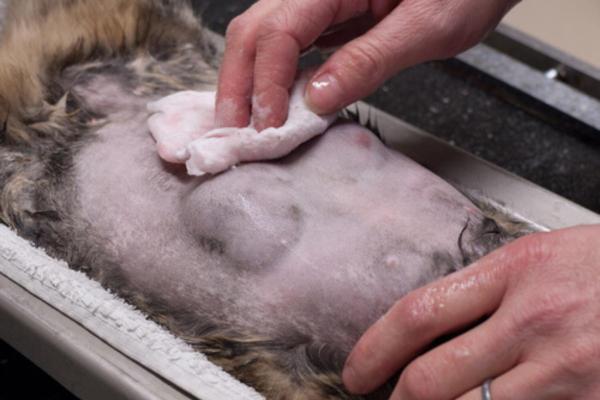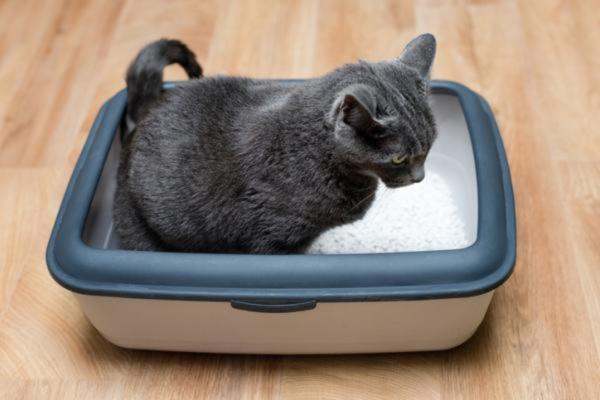Intestinal Adenocarcinoma in Cats



See files for Cats
As with humans, cancer in cats is a disease which can vary in severity and possess many potential complications. These complications can have varying effects on the cat's health, often not resulting in symptoms until the cancer has progressed significantly. In addition to lymphoma, adenocarcinoma is one of the most frequent feline intestinal cancers in cats. It is a malignant invasive tumor which affects both the large and small intestine. It has a poor prognosis once detected. Clinical signs arise from intestinal obstruction and surgery is required for treatment.
AnimalWised explains more about this type of feline intestinal cancer with our guide to intestinal adenocarcinoma in cats. We look into closer detail at its causes, symptoms and treatment so you can know what to expect if your cat has this type of cancer.
What is an intestinal adenocarcinoma in cats?
Intestinal adenocarcinoma in cats is a type of colorectal tumor which is most frequent in older cats. Other predisposing factors include breed and sex as Siamese and male cats appear to be most affected by this type of carcinoma, respectively.
It is a tumor that mainly affects the jejunum (second section of small intestine) ileum (final section of small intestine). Adenocarcinomas are locally infiltrating tumors and usually cause symptoms similar to those caused by intestinal obstruction in cats. It is also common for these tumors to ulcerate, which can cause blood in the cat's feces, especially bloody diarrhea.
Intestinal adenocarcinoma in cats affects the glandular epithelium. It originates in the lining cells of the internal secretion glands of the intestine and produces a circumferential thickening of the intestinal wall.
They are tumors that can arise both in the large and small intestine. They present with rapid growth, giving rise to symptoms similar to those of a partial intestinal obstructive processes. They also have a high rate of metastasis to local lymph nodes, invading the intestine quite extensively.
Not only does intestinal adenocarcinoma affect the intestines, but it can also appear in other parts of the feline gastrointestinal tract. These include the stomach or rectum.
Symptoms of intestinal adenocarcinoma in cats
As stated above, the clinical signs of feline intestinal adenocarcinoma are similar to those of gastrointestinal obstruction or blockage. The most common symptoms include:
- Vomiting
- Diarrhea
- Appetite loss
- Weight loss
- Vomiting blood (hematemesis)
- Digested blood in feces (melena)
- Fresh blood in the stool (hematochezia)
- Difficulty passing stool or tenesmus
- Abdominal pain in the mesogastrium (middle abdominal region)
When the disease progresses, weakness and decay will also appear. Metastasis to the mesenteric lymph nodes is common, resulting in life threatening complications for the cat.

Causes of intestinal adenocarcinoma in cats
As with many types of feline cancer, intestinal adenocarcinoma in cats has no clear established cause. It is not known why the cells mutate and acquire infiltrative and rapid growth capacity, nor how they affect the correct organic functionality and are able to spread to other locations.
Although the cause is not clear, there are risk factors of intestinal adenocarcinoma in cats. Since it is most commonly diagnosed more in older cats, we know that age is such a factor. Studies show that males are more susceptible than females and the most predisposed breed seems to be Siamese cats. It is reportedly diagnosed about 8 times more than in types of Siamese cats that any other breed.
Diagnosis of intestinal adenocarcinoma in cats
If you suspect your cat has intestinal adenocarcinoma, the first thing you need to do is take them to a veterinary center. They will out a anamnesis (medical history) and physical examination of the animal in order to obtain more information. If they believe there is either the presence of a tumor or another type of gastrointestinal obstruction, they will need to perform further diagnostic tests.
A complete blood work of the dog will be required with analysis in a laboratory. In positive cases of adenocarcinoma, blood chemistry may show mild to severe anemia due to loss of blood in vomit and/or feces. Leukocytosis will shift to the left, there will be a drop in albumin, a slight increase of alkaline phosphatase and a reduction in phosphorus.
To diagnose the intestinal tumor, diagnostic imaging techniques such as ultrasound and contrast radiography are used. Definitive diagnosis of feline intestinal adenocarcinoma is made from a sample taken by biopsy of the lesion and its histopathological study in the laboratory.
Treatment of intestinal adenocarcinoma in cats
The treatment of intestinal adenocarcinoma is complicated. It is not a tumor that is particularly sensitive to chemotherapy which is considered ineffective and it is not usually recommended in these patients.
Tumor removal or resection surgery is considered the treatment of choice. However, it is not usually curative due to the presence of metastases at the time of diagnosis in the vast majority of cases[1]. This surgery consists of removing the part of the damaged intestine and rejoining it with the healthy parts. Analgesics are also often prescribed as palliatives for the pain that this tumor usually produces in affected cats.
Prognosis of intestinal adenocarcinoma in cats
Despite the fact that it is a tumor with a poor prognosis or a reserved prognosis, correctly performed surgery may allow the cat to live a few more years, even if there are metastases in the regional nodules. Learn more about other types of malignant feline tumors with our article on breast cancer in cats.

Prevention of intestinal adenocarcinoma in cats
As with the vast majority of tumors, feline intestinal adenocarcinoma cannot be prevented in any significant way. If your cat has the genetic potential to be sensitive to tumors, they will have a greater potential of developing an intestinal cancer.
What we can do is try to ensure early detection. Early detection and early administration of treatment is the best chance for your cat's survival. If they have the risk factors which can predispose them to any type of gastrointestinal cancer, we need to ensure we hace regular veterinary checkups. This can include periodic abdominal ultrasounds would be necessary, something that is not usually done routinely.
This article is purely informative. AnimalWised does not have the authority to prescribe any veterinary treatment or create a diagnosis. We invite you to take your pet to the veterinarian if they are suffering from any condition or pain.
If you want to read similar articles to Intestinal Adenocarcinoma in Cats, we recommend you visit our Intestinal problems category.
1. Cribb A. E. (1988). Feline gastrointestinal adenocarcinoma: a review and retrospective study. The Canadian veterinary journal = La revue veterinaire canadienne, 29(9), 709–712.
https://www.ncbi.nlm.nih.gov/pmc/articles/PMC1680855
- L. Eusebius. (2003). Veterinary Medical Pathology: Textbook for the Teaching of the Subject . Kadmos Printing.







